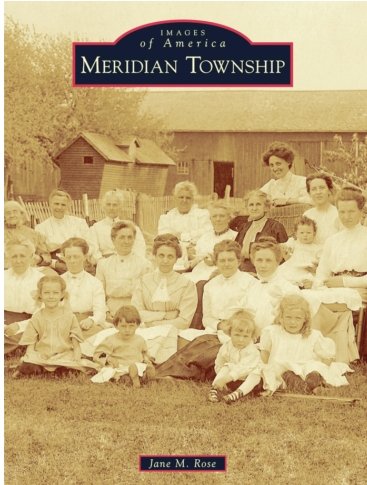 The Meridian Township most of us think of is the bustling shopping area where Grand River Avenue meets Marsh Road. But tucked behind the mall is Meridian Historical Village, which has preserved seven of the area’s historic buildings.
The Meridian Township most of us think of is the bustling shopping area where Grand River Avenue meets Marsh Road. But tucked behind the mall is Meridian Historical Village, which has preserved seven of the area’s historic buildings. Jane Rose has served as executive director of Meridian Historical Village for 13 years, a position she took after retiring from the State of Michigan. She is also author of the recently published “Images of America: Meridian Township,” a combination photographic guide and history of the area’s growth.
“I wanted to be a history teacher, that was my original professional goal,” Rose said. “I love history so much and love to share my knowledge and that of our volunteers with our visitors.”
Rose’s book has become a companion piece for telling the Meridian Township’s history. The area’s first residents were the Chippewa and Ottawa tribes, who camped in the area during their seasonal migrations. White settlers made their foray into the area in 1836 with a settlement at Pine Lake (now Lake Lansing).
In the book, Rose shows how the area around what is now called Haslett quickly became an agricultural center with a grain elevator, mill, post office, general store and rail service. Even greater changes came in 1887 when James Haslett, a Port Huron businessman, purchased property on the Southwest corner of Pine Lake.
Haslett established a major spiritualism center on the site. Each summer, thousands of believers and mediums would gather to camp and receive spiritual instruction. The boom would soon create a cottage and tourist industry that attracted the likes of the R.E. Olds family. But the camp was short-lived. After Haslett died in 1891, his widow sold the property in 1898 to the Haslett Park Association, which turned the property into a bustling summer resort.
“Haslett was the attraction in that era,” Rose said. “Pine Lake became the Traverse City or Charlevoix of the area.”
A trolley, which had been built to serve the spiritualist camp, was extended to a new casino which set out over the lake. A fleet of small boats serviced the area and a “gentleman’s club” was built in the center of the lake.
Photographs from the Meridian Historical Village’s archives, along with photographs from local residents and the Ingham County Parks Department, illustrate the book and show a lost era that many residents are not aware of.
“Finding high quality photographs to illustrate the book was the most difficult job,” Rose said.
Particularly disappointing, she said, was the failure to find any photographs of the Dells Ballroom, a nightclub built in 1910 on the north shore of the lake.
“It was incredibly popular in the big band era,” she said.
She’d also like to find a photograph of the Methodist church which was located in what she calls the “forgotten hamlet” at the intersection of Jolly and Meridian roads.
One section of the book covers the transition of Pine Lake to Lake Lansing. The area was renamed by a major property owner, Frank Johnson, in 1927. He thought the name Pine Lake was too common. By the 1920s, amusement rides began appearing. The Lake Lansing Amusement Park became a summer destination that lasted until the 1970s.
Another section of the book tells the story of the creation of the Meridian Historical Village. The project began in 1974 when the Grettenberger family donated the family’s original farmhouse to the village. Dramatic photographs show that home and several other buildings being moved into the village on flatbed trucks. The site is home to seven 19th century structures, including homes, businesses and a schoolhouse.
Rose also included some rare images of early area pioneer families, including the Fosters, the Grettenbergers, the Ayers and the Turners.
A photograph of the area’s first library, which was in the village of Okemos at the corner of Moore Street and Hamilton Road, shows a young boy with a woman, presumably his mother, coming from the library. Her saddle shoes date the photo around 1950.
The photo gracing the cover of the book is of the Haslett Woman’s Literary Society, which morphed into the contemporary Haslett Woman’s Club. The photo, taken in 1911, shows a gathering of young women with children posed against a barn. The women, in their finest Sunday clothes, are a stern group — except for the Gibson Girl look-alike in the back, glowing with a smile.
The village will host a Victorian Christmas celebration on 1 p.m. to 4 p.m. Dec. 13. Houses will be decorated for Christmas and volunteers in period dress will share their traditions. A Christmas tea in the Barnes House ($10 and reservations required) will be 1p.m. to 2 p.m. Buildings are open 2 p.m. to 4 p.m., and a tree lighting will take place at 4 p.m.
The book is available at local bookstores and can also be purchased online at meridianhistoricalvillage.com. Although the book has her name on the cover, Rose said that much of the credit belongs to the area’s history keepers.
“I stand on the shoulders of those who have gone before me and who share their memories and history in order to keep the past alive,” she said.
Support City Pulse - Donate Today!
Comments
No comments on this item Please log in to comment by clicking here